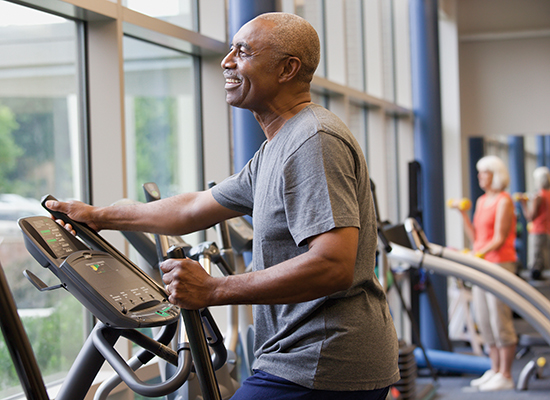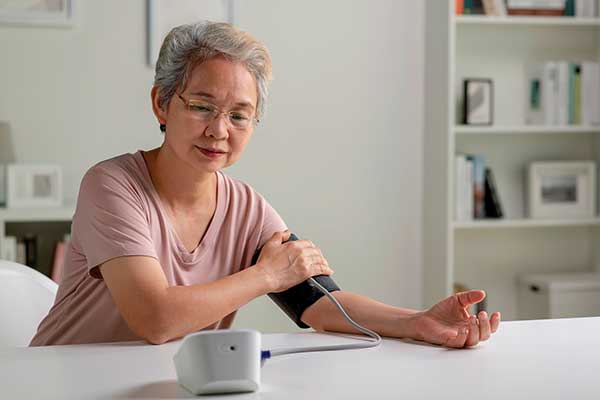HEALTHY LIVING
Men’s health matters

5 tips to maintain overall wellbeing
(Family Features) While family history and age cannot be changed, there are everyday steps men can follow to take charge of their health, including prostate health, and maybe even prevent problems down the road.
Consider these tips to help lead a healthier lifestyle.
Get checked out regularly. Just because you’re healthy doesn’t mean you should eschew routine checkups, and that includes self-examinations. While regular visits to your health care provider can keep you up-to-date on preventative screenings and immunizations, getting to know your own body can have similar benefits.
Care for your prostate. If you’re experiencing frequent urination, a weak or slow urine stream, incomplete bladder emptying, difficulty or delay in starting urination or a urine stream that stops and starts, these may be signs you may be suffering from Benign Prostatic Hyperplasia (BPH), otherwise known as enlarged prostate.1 Enlarged prostate, which is non-cancerous and affects more than 40 million American men, can also cause loss of productivity and sleep, according to research published in the “Journal of Urology.”2,3 Medication is often the first line of treatment, but some patients may suffer uncomfortable side effects including dizziness, headaches and sexual dysfunction, which can prompt them to quit using their medications.4
“Many men living with BPH symptoms take prescription medications after they have been diagnosed, but relief can be inadequate and temporary,” said Dr. Peter Walter, M.D., urologist and paid consultant for Teleflex Incorporated, the manufacturer of the UroLift® System.
As one alternative to medication, an option like the UroLift System treatment is a minimally invasive procedure that doesn’t require any cutting, heating or removal of prostate tissue.5 A urologist places small implants to lift and move enlarged prostate tissue so it no longer blocks the urethra and can allow for normal urine flow. Most common side effects are mild to moderate, and patients generally can return to their normal routines with minimal downtime. For more information about treatment options, or to find a urologist near you who treats BPH, visit UroLift.com.

Focus on a more nutritious diet. Aim for a pattern of healthier eating that includes more fruits, vegetables and leafy greens such as lettuce, spinach, kale and broccoli, which can help keep you – and your prostate – healthy.6 Also try to cut back on consumption of red meat – specifically processed meat – as well as salt and sweets.
Know your numbers. Be sure to discuss your family history and lifestyle with your doctor as he or she may recommend screenings for diseases and common ailments. Be sure to keep up with these screenings and check in with your doctor to make sure you’re accounting for milestone ages and common ailments associated with aging.
Make exercise a priority. Exercise is a key to maintaining quality of life. The American Heart Association recommends at least 150 minutes per week of moderate-intensity aerobic activity for adults.7 Even shorter increments of physical activity multiple times a day such as a walking meeting, opting for the stairs instead of the elevator or parking farther from your destination can provide health and stress-relieving benefits.
Photos courtesy of Getty Images
1. Speakman et al. 2014 BJUI International
2. Berry, J Urol 1984 and 2017 U.S. Census population estimates.
3. NeoTract US Market Model estimates for 2018 based on IMS Health Drug and Procedure data
4. AUA BPH Guidelines 2003, 2010, 2018
5. Roehrborn J Urol 2013 LIFT Study
6. Tips for Keeping a Healthy Prostate. (n.d.) Retrieved from https://www.hopkinsmedicine.org/health/wellness-and-prevention/tips-for-keeping-a-healthy-prostate
7. www.heart.org. (2019). American Heart Association Recommendations for Physical Activity in Adults and Kids. [online] Available at: https://www.heart.org/en/healthy-living/fitness/fitness-basics/aha-recs-for-physical-activity-in-adults
SOURCE:
UroLift
HEALTHY LIVING
A guide to great skin at any age

(Family Features) Here’s the secret for achieving a glowing complexion: there is no secret. In fact, a key factor in achieving great skin at any age comes down to one common denominator that’s no secret at all. It’s simply taking good care of your skin.
After all, your skin is your body’s single largest organ. It’s your protective shield, but it can also reveal the truth of your age, especially if you’re lax when it comes to regular skin care.
Make hydration a priority. Keeping the skin hydrated maintains its barrier integrity. When the skin becomes dry, it reduces the effectiveness of the skin barrier, making it less resilient against irritants and allergens.
Often, when the skin is dry it feels more rough or flaky. With proper hydration, the skin feels smoother and looks more supple. Achieving hydration through a better skin care routine, drinking plenty of water daily and eating certain fruits and vegetables can improve your skin’s appearance, maintaining a radiant, healthy complexion.
Use the right soap. Despite what your mother may have told you, squeaky clean isn’t always best. A better bet when it comes to soap is a product that respects your skin’s moisture balance and cleanses without creating tightness or irritation.
Mild options such as Pears skin cleansing products are specifically formulated and dermatologically tested to be gentle on the skin. They’re made with plant-based glycerin, which is a powerful humectant that attracts water from the environment and deeper layers of the skin to the outer layer, keeping it hydrated. Glycerin-based cleansers can help prevent stripping of the skin’s natural oils, which averts a tight, dry feeling.
“More than ever, consumers are looking for mild and gentle products that are effective, smell good and work well,” said Dr. Adriana Lombardi, founder of the Skin Cancer & Cosmetic Surgery Center of New Jersey. “Pears soap checks all the boxes. It creates a really nice, thick lather and smells crisp and clean while leaving the skin hydrated.”
Avoid hot showers. Even the best products may not overcome the potential harm that comes from taking showers that are too hot. The heat removes your skin’s natural oils, which leaves you prone to itching and dryness and may worsen skin conditions.
Instead of cranking up the heat, opt for lukewarm temperatures and keep the shower time brief. Use moisturizing cleansers, and after your shower, immediately apply moisturizer to replenish and rehydrate your skin.
Protect your skin from the sun. After completing your skin cleansing routine, there’s an additional step to help maintain healthy, hydrated skin before heading outdoors: Take time to apply a layer of sunscreen to skin that will be exposed, including your face, ears and hands. Reapply every two hours if you’re spending a great deal of time outside. Sun damage can prematurely age the skin. You may not feel the heat as much during colder times of year, but the rays are still capable of damaging your skin, maybe even more so because you don’t feel the burn
Find more advice for keeping your skin supple and soft at Amazon.com/pears.
3 Steps to Practice a Healthy Skin Routine
- Use a humidifier in your room. Adding moisture to your environment may help prevent over-drying and promote better air quality for your overall health, including your skin.
- Use glycerin-based soap. A glycerin-based soap like Pears gently cleanses your skin without stripping essential moisture.
- Moisturize immediately after showering. Showering, especially at higher water temperatures, can strip your body’s natural oils. Applying lotion immediately after you shower helps retain the moisture your body nee
Photos courtesy of Shutterstock (woman applying moisturizer, man applying moisturizer)
SOURCE:
Pears
HEALTHY LIVING
Harness the power of walking

(Family Features) A walk isn’t just good for your body; it’s a simple, powerful way to care for your mind and soul. Physical activity, like walking, reduces stress, boosts mood and promotes overall well-being. Yet physical activity levels in the United States continue to decline, a trend threatening both mental and physical health.
Less than half of adults and fewer than 1 in 5 children in the U.S. get the recommended amount of physical activity needed for heart health, according to the American Heart Association’s 2025 Heart & Stroke Statistical Update.
National recommendations call for children to get at least one hour of physical activity each day, but the latest statistics show less than 19% of children in the U.S. achieve that target. Meanwhile, less than half of adults get the recommended 150 minutes or more of weekly physical activity.
What’s more, according to data from a National Health and Nutrition Examination Survey, 1 in 4 U.S. adults sits for longer than eight hours each day, which can have negative consequences on physical and mental health.
For decades, the American Heart Association has championed the importance of physical activity in communities across the country through events like National Walking Day on Wednesday, April 2. These tips and information can help you understand how a brisk walk can make a world of difference for heart health and mental clarity.
Benefits of Physical Activity
Staying active is one of the best ways to keep your mind and body healthy.
The physical health benefits may be obvious, but research suggests physical activity can also help bring more joy to your life. According to the 2019 Physical Activity Guidelines for Americans, people who get the recommended amount of physical activity are less likely to experience depression.
Regular physical activity enhances your mood, sharpens your mind, improves sleep and boosts overall well-being, all while reducing the risk of disease and depression and increasing both the quality and longevity of life.
How to Be More Physically Active
Exercise as simple as a brisk walk can put a major spring in your step. It can even energize you to finish other tasks at hand, whether it’s cooking or running errands. Give your daily physical activity level a boost with these tips:
- Exercising outdoors is a great way to get moving. Spending time outdoors has been shown to reduce stress, promote a sense of belonging and improve mood. It’s even better if you can enjoy the sunshine outside, which can improve mood, boost your immunity and help you get some vitamin D.
- Invite a family member or friend along with you. It’s good for them, it’s good for you and it’s good company all around.
- Instead of wondering if you’ll move today, explore how you’ll move. A walk, a dance or a stretch all count.
Getting Pets Involved
Pets are part of your family, and they can help you get healthy together. Pets provide a fun reason to spend more time outside and get the exercise needed to reduce the risk of disease later in life.
Getting moving along with your pet adds more exercise to your routine, which means living longer, reducing risk of dying from heart attack or stroke, reducing risk of diabetes, reducing stress and even boosting your overall happiness and well-being.
Exercising with your pet can also mean enjoying more socializing. You may find yourself meeting other dog owners in your area on a walk or at the dog park.
Learn more about how simple habits like walking can support your overall health at heart.org/MoveMore.
Photos courtesy of Shutterstock
SOURCE:
American Heart Association
HEALTHY LIVING
Know these 4 core factors to avoid a heart health syndrome

(Family Features) In the U.S., 1 in 3 adults is at risk for a newly recognized syndrome that comes from a combination of heart disease, kidney disease, type 2 diabetes and excess body weight. This cluster of conditions, called cardiovascular-kidney-metabolic (CKM) syndrome, is an example of how problems in one part of your body can affect other parts.
To avoid CKM syndrome, health experts suggest paying close attention to four of the American Heart Association’s Life’s Essential 8 – blood pressure, lipids, body weight and blood sugar level – which are core health factors that impact your metabolic health.
Good metabolic health means your body uses energy well and keeps these factors in a normal range. However, when numbers are off in one area, it can affect others, raising your risk for heart disease, stroke, kidney disease and diabetes.
Consider these tips from the American Heart Association to help keep your core health factors under control.

Blood Pressure
High blood pressure, also known as hypertension, happens when the force of your blood pushing against the walls of your blood vessels is too high. High blood pressure is a leading cause of heart disease, stroke and kidney disease.
Because high blood pressure doesn’t have symptoms, the only way to know you have it is to get your blood pressure checked. Healthy blood pressure is below 120/80. If your blood pressure is 130/80 or higher, talk to your doctor about checking your other core health factors.
Lifestyle changes can help reduce high blood pressure. One example is a Dietary Approaches to Stop Hypertension (DASH) eating pattern that’s low in fat and rich in fruits, vegetables, whole grains and low-fat dairy products. Losing 10 pounds and reducing alcohol consumption can also reduce blood pressure.
Cholesterol
Cholesterol is a waxy substance your liver makes then circulates in the blood where your body uses it to build cells and make vitamins and hormones. You may also get cholesterol from eating animal products. If there’s too much cholesterol circulating, your risk of type 2 diabetes, heart disease and stroke may increase.
For optimal CKM health, your LDL cholesterol should be below 100 and triglycerides below 150. Triglycerides are the most common type of fat in the body. If your triglyceride level is 135 or higher, talk to your doctor about decreasing your risk.
Losing body weight and increasing physical activity decrease triglyceride levels. In addition, DASH and Mediterranean (plant-based, high-fiber, low-fat) eating patterns support healthy LDL and triglyceride levels.
Body Weight
Healthy weight may be determined by body mass index (BMI), a number that represents your weight in relation to your height. Extra body fat can mean a higher risk for many health problems, including heart disease, stroke, high blood pressure, high cholesterol and diabetes.
CKM syndrome starts when BMI is 25 or higher and waist circumference is 88 centimeters or higher for women and 102 centimeters or higher for men. Aim for a BMI between 18.5-25.
To lose weight and keep it off, start by setting realistic goals. Understand how much and why you eat, manage portion sizes, make smart snack substitutions and be physically active.
Blood Sugar
High blood sugar can slowly damage the kidneys. In fact, diabetes is the leading cause of kidney disease, and it increases the risk of heart attack and stroke.
Blood sugar is measured in two ways: a fasting blood glucose test (short term blood sugar) and an A1C test (long term blood sugar control). A normal fasting blood glucose level is 70-99 and a normal A1C level is below 5.7%. Fasting blood glucose above 125 and A1C of 6.5% or higher means you have diabetes.
Habits that help you avoid high blood pressure, weight gain and high cholesterol also keep your blood sugar in check. These are especially important if you have a family history of diabetes.
Learn more about CKM syndrome and how to manage your risk at heart.org/CKMhealth.
Photos courtesy of Shutterstock
SOURCE:
American Heart Association
-

 NEWS2 years ago
NEWS2 years ago2 hurt, 1 jailed after shooting incident north of Nocona
-

 NEWS1 year ago
NEWS1 year agoSuspect indicted, jailed in Tia Hutson murder
-

 NEWS2 years ago
NEWS2 years agoSO investigating possible murder/suicide
-

 NEWS2 years ago
NEWS2 years agoWreck takes the life of BHS teen, 16
-

 NEWS2 years ago
NEWS2 years agoMurder unsolved – 1 year later Tia Hutson’s family angry, frustrated with no arrest
-

 NEWS2 years ago
NEWS2 years agoSheriff’s office called out to infant’s death
-

 NEWS2 years ago
NEWS2 years agoBowie Police face three-hour standoff after possible domestic fight
-

 NEWS2 years ago
NEWS2 years agoDriver stopped by a man running into the street, robbed at knifepoint







